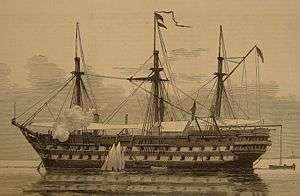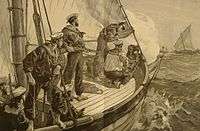HMS London (1840)
HMS London was a two-decker 90-gun second-rate ship of the line of the Royal Navy, launched on 28 September 1840 at Chatham Dockyard.[1]
 HMS London depicted in Zanzibar 1881 | |
| History | |
|---|---|
| Name: | HMS London |
| Builder: | Chatham dockyard |
| Laid down: | October 1827 |
| Launched: | 28 September 1840 |
| Fate: | Sold for breaking up, 1884 |
| Notes: | Converted to a 72-gun third rate screw ship, 1858 |
| General characteristics [1] | |
| Class and type: | Rodney-class ship of the line |
| Tons burthen: | 2598 bm |
| Length: | 205 ft 6 in (62.64 m) (gundeck) |
| Beam: | 54 ft 5 in (16.59 m) |
| Depth of hold: | 23 ft 2 in (7.06 m) |
| Propulsion: | Sails (and steam, after 1858) |
| Sail plan: | Full rigged ship |
| Armament: |
|
In 1854, London took part in the bombardment of Fort Constantine at Sevastopol during the Crimean War, where she sustained damage.
In 1858 she was converted to screw propulsion,[1] and reduced to 72 guns.
By 1873, she was a hulk, serving as a depot ship in Zanzibar Bay, off the east coast of Africa. In March 1878 she was recommissioned, and involved in the suppression of the slave trade in the area, serving as a central depot for many smaller steam screw boats; she functioned as a repair depot, a hospital and a storage ship. At this time there were Africans from West Africa (Kroomen or Krumen) and East Africa (Seedies or Sidis) serving on board. There were also Zanzibari and Arab interpreters and cooks from Portuguese Goa (India).


Captained by Charles J Brownrigg, this vessel and her crew made several patrols aimed at hindering the slave trade and, on 3 December 1881, caught up with a slave dhow captained by Hindi bin Hattam. This dhow had around 100 slaves on board and was transporting them between Pemba and Zanzibar. Captain Brownrigg led a boarding party to release the slaves but bin Hattam's men then attacked the sailors, killing Brownrigg and some of his party before sailing away. Sir Lloyd William Mathews led a force to Wete on Pemba and, after a short battle, took a mortally wounded bin Hattem (Hindi-bin-Khartoum[2]) prisoner before returning to Zanzibar.
In late 1881, while the vessel was at Zanzibar, it suffered damage of a nature such that repairs were urgently required. The type of wood desired to make the repairs was teak, which "could not readily be procured in the open market." The Sultan was, however, known to have a store of the desired timber and so he was requested to assist with supplying it. This he did and the repairs done. However, the Sultan refused to accept any payment for the supplies. In the eyes of the commander of HMS London, it put the British Royal Navy "in an awkward position" because it would be very difficult to make similar requests in the future.[3]
The final entry in the ship's log is dated 22 January 1883. Captain Luxmoore writes "Paid ship off" "Sent ships company to transport Windsor Castle in passage to England".
In 1884 she was sold and broken up.[1]
| List of Pinnace (ship's boat) attached to HMS London for the actual pursuit and capture of the slavers Dhow (ship),
Sept 1880 to Sept 1882[4] | |
|---|---|
| Boat | Date the most slaves were rescued by Boat |
| Helena | 2 slaves rescued on 21 September 1880 |
| L. Cutter | 99 slaves rescued on 20 October 1880 by Lt. Smith |
| Beatrice | 7 slaves rescued on 12 November 1880 by J. Bishop |
| Victoria | Dhow capture 10 December 1880 by Lt. Smith |
| Depot | 25 slaves rescued on 18 December 1880 by George Taylor |
| L.Pinnace | 19 slaves rescued on 19 April 1881 by Lt. Elliott |
| Wave | 137 slaves rescued on 15 October 1881 by Lt. Travers. (On 3 December 1881 Captain Brownrigg was killed by Arab slavers while commanding this boat)[5] |
| Alexandra | 6 slaves rescued on 4 September 1881 by G. Kive |
| Sunbeam | 5 slaves rescued on 27 March 1880 by Lt. Travers |
| Alice | 8 slaves rescued on 29 September 1881 by W. Price |
| L. Launch | 1 slave rescued on 5 December 1881 by Lt. Cutfield |
| Galley | 1 slave rescued on 8 December 1881 by R. Redding |
| Mermaid | 3 slaves rescued on 15 September 1882 by Captain Luxmoore |
Notes
- Lavery, Ships of the Line vol.1, p190.
- House of Commons papers, vol 66, pg189.
- Captain Charles J Brownrigg to Liet. Colonel SB Miles, Aug 22 1881. (enclosed in (Lt. Colonel Miles to Granville, Nov 21 1881. FO 84/1601)
- File:Dhows captured HMSLondon.jpg
- British and Foreign State Papers 1880-1881 Vol. LXXII. pg 817
References
- Lavery, Brian (2003) The Ship of the Line - Volume 1: The development of the battlefleet 1650-1850. Conway Maritime Press. ISBN 0-85177-252-8.
- House of Commons papers by Great Britain. Parliament. (1883), vol. 66, p. 189.